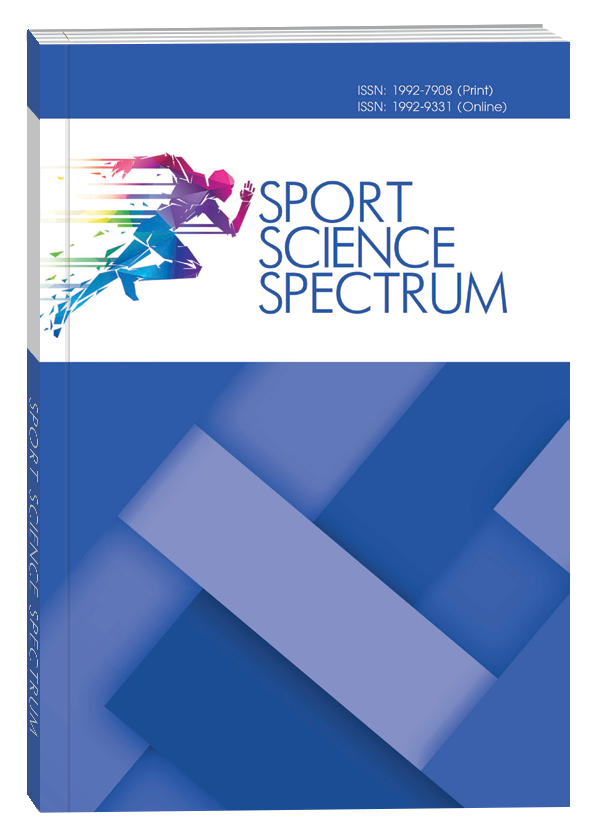MODELLING OF THE TECHNICAL ACTIONS OF TRACK AND FIELD ATHLETES SPECIALIZING IN RACE WALKING IN THE SYSTEM OF LONG-TERM PREPARATION
DOI:
https://doi.org/10.32782/spectrum/2024-1-2Keywords:
biomechanical characteristics, technical training, race walking, long-term improvement system, neural networks, modelingAbstract
One of the priority directions for optimizing the process of technical preparation of track and field athletes who specialize in race walking in the system of long-term improvement is the creation of well-defined criteria for improving the technical actions of athletes using modern modeling technologies. Today, neural networks are among the most advanced modeling technologies used in sports and athletics in particular. Objective. Improving the technical training of track and field athletes who specialize in race walking based on computer modelling of the technical actions of athletes in the long-term training system using artificial neural networks. Methods. Analysis of scientific and methodological literature, video recording with biomechanical computer analysis of athletes’ motor actions, modelling, and methods of mathematical statistics. The results. Informative anthropometric and biomechanical characteristics of the technique of track and field athletes specializing in race walking at the first and second stages of long-term training were analyzed. The biomechanical analysis of technical actions was carried out based on video footage of the 2014–2021 race walking championships of Ukraine in different age groups at the first and second stages of long-term training for men at distances of 3, 10 and 20 km and for women at distances of 2, 10 and 20 km. 181athletes were involved in the study: men – 98, of which 31 are at the distance of 3 km, 36 – 10 km, and 31 – 20 km; 83 women, 20 of them at the distance of 2 km, 32 – 10 km, and 31 – 20 km. As a result, a technology for modelling the technical actions of track and field athletes specializing in race walking in a system of long-term training via artificial neural networks was developed. The simulation algorithm, which allows modelling and forecasting the level of sports results at all levels (generalized, group, and individual) depending on gender at various stages of long-term improvement was presented. Multifunctional biomechanical models of the technique of track and field athletes specializing in race walking in the system of long-term training were elaborated.
References
Бобровник В.И. Совершенствование технического мастерства спортсменов высокой квалификации в легкоатлетических соревновательных прыжках : монография. Киев : Науковий світ, 2005. 322 с.
Бобровник В., Совенко С. Удосконалення технічних дій легкоатлетів, які спеціалізуються у спортивній ходьбі, у системі багаторічної підготовки. Теорія і методика фізичного виховання і спорту. 2023. № 2. С. 3–15. DOI: 10.32652/tmfvs.2023.2.3-15.
Платонов В.Н. Система подготовки спортсменов в олимпийском спорте. Общая теория и ее практические приложения : учебник для тренеров : в 2 кн. Киев : Олимпийская лит., 2015. Кн. 1. 680 с ; Кн. 2. 752 с.
Біомеханіка спорту : підручник / О.Ю. Рибак, Л.І. Рибак, Б.А. Виноградський та ін. Львів : ЛДУФК ім. Івана Боберського, 2021. 268 с.
Совенко С. Технико-тактические особенности преодоления дистанции в спортивной ходьбе. Наука в олимпийском спорте. 2020. № 1. С. 81–90.
Субботін С.О. Нейронні мережі: теорія і практика : навчальний посібник. Житомир : Вид. О.О. Євенок, 2020. 184 с.
Уоссермен Ф. Нейро-компьютерная техника: Теория и практика / пер. с англ. Ю.А. Зуев, В.А. Точенов. Киев, 1992. 184 с.
Хуртик Д.В. Удосконалення технічних дій висококваліфікованих лижників з порушенням слуху на основі комп’ютерного моделювання : дисертація. Київ : НУФВСУ, 2018. 192 с.
Хуртик Д., Хмельницкая И., Смирнова З. Моделирование технических действий лыжников-гонщиков высокой квалификации. Наука в олимпийском спорте. 2019. № 2. С. 55–62. DOI: 10.32652/olympic2019.2_6.
Шестаков М.П. Управление технической подготовкой в легкой атлетике на основе компьютерного моделирования. Наука в олимпийском спорте. 2005. № 2. С. 187–196.
Hanley B., Bissas A., Drake A. Kinematic characteristics of elite men’s 50 km race walking. European Journal of Sport Science. 2013. № 13 (3). Р. 272–279. DOI: 10.1080/17461391.2011.630104.
Hanley B., Bissas A., Drake A. Technical characteristics of elite junior men and women race walkers. The Journal of sports medicine and physical fitness. 2014. № 54 (6). Р. 700–707.
Hoga-Miura K., Hirokawa R., Sugita M. A three-dimensional kinematic analysis of walking speed on world elite women’s 20-km walking races using an inverted pendulum model. Gazzetta Medica Italiana Archivio per le Scienze Mediche. 2020. № 179 (1–2). Р. 29–38. DOI: 10.23736/S0393-3660.18.04009-3.
Kinetic analysis of the function of the upper body for elite race walkers during official men 20 km walking race / K. Hoga-Miura et al. Journal of Sports Medicine and Physical Fitness. 2016. № 56 (10). Р. 1147–1155.
Neural network modelling of diagonal stride technique of highly qualified skiers with hearing impairments / Y. Imas et al. Journal of Physical Education and Sport. 2018. № 18. Supplement issue 2. Art 181. Р. 1217–1222. DOI: 10.7752/jpes.2018.s2181.
Maurer Harald. Cognitive science: integrative synchronization mechanisms in cognitive neuroarchitectures of the modern connectionism. CRC Press, 2021. 400 p. DOI: 10.1201/9781351043526.
Race Walking Ground Reaction Forces at Increasing Speeds: A Comparison with Walking and Running / G. Pavei et al. Symmetry-Basel. 2019. № 11 (7). 11 p. DOI: 10.3390/sym11070873.
Sovenko S. Technique characteristics of 13–15-year-old female athletes specializing in race walking at the stage of preliminary basic preparation. Journal of Physical Education and Sport. 2022. № 22 (1). Р. 85–90. DOI: 10.7752/jpes.2022.01010.
Tucker C.B., Hanley B. Increases in speed do not change gait symmetry or variability in world-class race walkers. Journal of Sports Sciences. 2020. № 38 (24). Р. 2758–2764. DOI: 10.1080/02640414.2020.1798730.
Vinogradova O.A., Sovenko S.P. Improving technical fitness of race walkers on the basis of special exercises to focus on key parameters of movements. Pedagogics, psychology, medicalbiological problems of physical training and sports. 2020. № 24 (2). Р. 100–105. DOI: 10.15561/26649837.2020.0208.
Wang J. Analysis of Sports Performance Prediction Model Based on GA-BP Neural Network Algorithm. Computational Intelligence and Neuroscience. 2021; Special Issue. Neural Network-Based Machine Learning in Data Mining for Big Data Systems. 12 p. DOI: 10.1155/2021/4091821.





